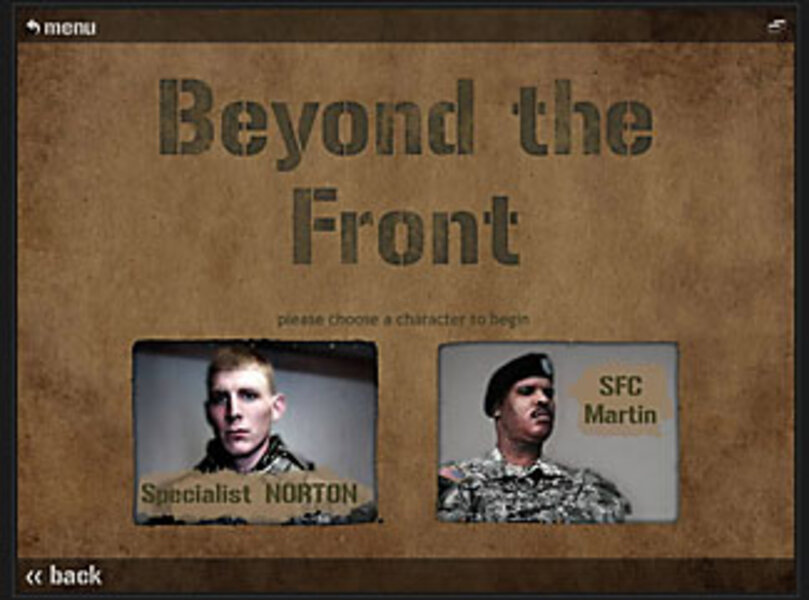Army uses video games in suicide prevention
| Washington
As the strains of war push the Army's suicide rate up to an all-time high, the service is turning to a fictional soldier named Spc. Kyle Norton to encourage soldiers to seek help faster.
Suicides among soldiers have increased dramatically in the last several years, up by 46 percent since the US invaded Iraq in 2003. Senior service officials recognize that the wars have affected soldiers in the form of post traumatic stress disorder and other manifestations of mental depression, but still haven't completely figured out how to address the issue.
The Army is conducting new training, handing out "buddy cards" to alert soldiers to problems among their friends, and recently announced a new five-year study to be undertaken with the National Institute of Mental Health.
But one of the more novel solutions is an interactive game called "Beyond the Front," starring Specialist Norton, a character in a kind of modern-day military morality play. The service plans to send out thousands of copies of the game – part of an Army suicide prevention program costing almost $1 million – to educate soldiers about the dangers of not seeking help when they most need it.
Role playing for real life problems
Users of the interactive video watch a drama unfold on screen and then make decisions that affect the outcome for the characters. In one scenario, Norton receives a "Dear John" letter, and then a roadside bomb kills a buddy, setting off a chain of events that require players to make decisions for the main character. Players who repeatedly choose to reach out to fellow soldiers and family members within the scenario get a happy ending. Players who opt – in their character – not to tell anyone about their problems will steer the game to a sad end.
Another scenario focuses on a soldier's role in preventing a buddy's suicide.
"People are drawn into it, they see themselves because [the situations in the movie] are very realistic," says Sharon Sloane, president and chief executive officer of WILL Interactive, which made the film and has produced such training films for more than a decade. "The problems resonate, and they feel the emotions of the characters because they look like and sound like and behave like them, so it becomes a first-person experience."
Ms. Sloane says the video gives soldiers a chance for players to walk in someone else's shoes.
"It's an opportunity to play it out before you live it out," she says.
The emergence of this relatively untested approach illustrates the difficulty the Army has in combating the effects of depression on a service exhausted by war.
Army suicides have increased from 79 in 2003 to 115 last year, not including attempts. About two-thirds were deployed or had deployed when they committed suicide. Senior Army officials expect this year's rate to be even higher. If so, the Army suicide rate could surpass that of the general US population of 19.5 per 100,000 people.
"One suicide is too many," says Col. Thomas Languirand, chief of Command Policies and Programs Division for the Army. He says the Army is not yet sure how exactly it will use the "Beyond the Front" video and won't say how many copies it plans to buy. It's just one "tool in the toolbox" for suicide prevention, says Colonel Languirand.
Ultimately, it's not about videos or pocket cards or any other programs, but about educating soldiers to look out for each other, he adds.
"If we can have soldiers understand what those behaviors are that may lead to suicidal behavior, we believe we can have them intervene and that is where we can have the most payoff."
The Marine Corps has its own problems. That service saw a high of 34 suicides in 2004, or 17.5 suicides per 100,000 marines, not including attempts. The number dropped to 25 in 2006 but has begun to increase again.
Persuading soldiers to get help
The key to suicide prevention lies in overcoming the stigma of seeking help. Individuals typically find it difficult to seek help for a mental disorder or even mild post-traumatic stress disorder in a military environment that stresses toughness and derring-do.
Earlier this year, Defense Secretary Robert Gates changed Question 21 on a Defense Department survey required for security clearance, exempting soldiers from reporting mental-health treatment related to combat injuries or family issues. The move was seen as a major step in recognizing that professional counseling is a positive step, not a negative one.
"It's time we made everyone in uniform aware that the act of reaching out for help is one of the most courageous acts – and one of the first steps – to reclaiming your career and future," said Adm. Mike Mullen, in announcing the change in May.
Soldiers or marines who return from war with mental disorders may be predisposed to having them. But the severity of the trauma they encounter there can also turn a healthy soldier or marine into a sick one, says Dr. Jan Fawcett, a psychiatrist who has consulted for both military and police departments.
"You can take people who look pretty healthy and run them through the ... grinder and they will come out in shards," he says.





